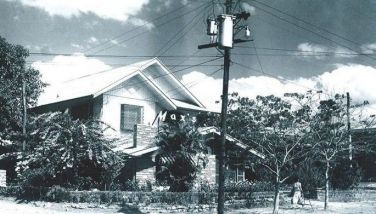Licensed To Kill
MANILA, Philippines - Arman dela Cruz (not his real name) just passed his actual driving examination in a small bus company. His operator told him that he can already start the following Monday. Excited about his new work, Arman couldn’t help but look forward to a promising life as bus driver.
Before leaving the employer’s tiny office, however, Arman was reminded by his new boss about a “secret”.
“Don’t tell anybody that I told you this,” the bus owner said in a hushed tone.
Arman listened intently, his mind hanging on his employer’s next words.
“If you figure in an accident, and I truly hope you don’t,” the bus owner said, knocking on his wooden desk with pictures of his loved ones under a clear plastic cover. “I did not tell you this, but if you must choose between a half-dead victim and a dead one, it is easier to deal with the latter.”
Arman, a former family driver, had heard similar advice once in a conversation with an elderly driver. But he wasn’t sure what it truly meant.
“Do you mean the company would rather have a dead victim than a victim who is alive yet injured?” Arman asked, just to confirm that he understood the instruction well.
The bus owner nodded and stared at the stack of paper on the left side of his desk.
“If the victim is alive and in the hospital, the bills never end. If the victim is dead, then we could already settle with the family and just pay them off.”
Arman was still having goosebumps as he replayed the conversation in his head on his way out of the bus terminal. He was wondering if his decision to be a bus driver – a job that would pay him at least P600 a day in commissions for a 10-hour work – was the right choice.
“Industry secret”
For 16 years, Dante Lantin served as chairman of the Land Transportation Franchising Regulatory Board (LTFRB), the agency in charge of regulating public utility vehicles such as buses. While having lunch at a hotel in Pasay City where he attended a road safety conference, he talked to this writer on the issue of some bus drivers being “licensed to kill”.
He acknowledged the story of Arman as the Philippine bus industry’s “dirty secret”.
“No bus owner would admit it,” he said. “But if you would look closely, that’s what’s happening. It makes more economic sense to have a dead victim than a victim who is half dead yet requires expensive medical treatment.”
Lantin recalled hearing stories in the 80s of drivers intentionally backing up to run over their victims after an accident to make sure they were dead. However, the lack of witnesses and the inability of the victims’ families to pursue the case in court had led to amicable settlements.
The present LTFRB chairman, Alberto Suansing, also acknowledged those stories. In a telephone interview, he said, “Before, I refused to believe those stories. But it seems they are true.”
Homer Mercado, president of the Provincial Bus Operators Association (PBOA), was quick to clarify that such stories usually happen to drivers employed by small bus companies. Having grown up in the bus business – his grandfather Gonzalo was an industry pioneer and founded one of the country’s first bus companies after World War II while his father Artemio put up JAM Liner in 1968 when Homer was only 12 years old. Now a bus company owner himself, he knows the industry too well.
“Big companies will not do that,” he said. “For us, we look at the long term. We take care of our image, our name. Through word of mouth, people would know your secret and it would be very costly in the end. For us, we shoulder the medical expenses no matter how big they are. That’s our responsibility. We will never tolerate, much less encourage, murder by our drivers.”
“Murder”
Suansing noted that drivers who intentionally kill their victims must be punished for murder and not just for reckless imprudence resulting in homicide, a crime that carries minimal penalties.
One documented case of intentional killing by a bus happened before 7 o’clock in the morning of Dec. 1, 1995 on the Caloocan portion of EDSA. A Delta Transport bus bound for Monumento was speeding as it overtook the pack of buses hunting for passengers at the peak of morning rush hour. It was about to pass a jeepney that was unloading passengers on the rightmost lane when 14-year-old Jocelyn Cacas, a student from Bulacan, crossed the road. The bus driver tried to hit the brakes but it was too late. He rammed the hapless girl whose body was thrown 20 meters towards the center of the highway.
Witnesses testified that after the impact, the bus momentarily stopped. When it moved again, it swerved to the direction of the badly injured girl and ran over her, killing her instantly.
The driver, Ronald Santiago, fled on board a taxi right after the incident for fear of being mauled by irate bystanders. His conductor, Rey Liones, wasn’t as lucky, though, as he was punched and kicked by witnesses who were appalled by what happened.
Santiago was later arrested. He denied that the killing was intentional, and that he did not see the girl cross the road. He was eventually convicted of murder and sentenced to life imprisonment. The Regional Trial Court initially ordered him to pay the family of his victim more than P1.2 million in damages but the Court of Appeals reduced the amount to P220,000.
Dr. Orlando Ocampo, head of the UP-PGH trauma division, who also attended the road safety conference with Lantin, said the penalty for deaths in vehicular accidents is very low – affordable in fact – for most bus operators.
“It’s the law that encourages bus drivers to become murderers. The law pegs the payment at a minimum of P50,000 for the loss of life but If the case doesn’t go to court – and it seldom does – then a quick-claim settlement could go as low as P20,000 for a dead child. For poor families especially in the provinces that couldn’t hire the services of a good lawyer, it wouldn’t take much convincing for them to settle for this measly amount.”
“Solutions”
Last August 25, the day after a Bicol-bound Lucena Lines bus collided head-on with a Manila-bound Bragais Liner bus from Tabaco, Albay, a tragedy that left nine people dead and 41 seriously injured, LTFRB Chairman Alberto Suansing met with bus operators to express his anger and frustration at what happened. For him, a vehicular crash is no accident since it could have been prevented.
He challenged bus company owners to focus on three very important aspects of their business that matter most in ensuring safety on the road – hiring, welfare, and monitoring of drivers. These aspects, to his mind, are what would spell the difference between a bus that is safe and another bus that is a potential murderer on the road.
Suansing wants bus companies to screen fully the drivers they hire by making them undergo various examinations that would evaluate not only their skills but also their psychological state and overall behavior.
“A motor vehicle is a lethal weapon in the hands of a deranged driver,” he stressed.
Suansing also wants company owners to ensure that their bus drivers are treated well, given ample rest, and paid honest wages. He has observed that many accidents happen because of driver fatigue, which kicks in after the driver has been on the wheel for more than eight hours.
“Most fatal crashes happen on long-haul trips – those trips to Bicol and the Visayas. Many drivers on these routes are driving half awake. They are potential killers on the loose,” he said.
On the issue of salaries, Suansing prefers a combination of fixed basic salary and commission which is what’s being practiced by major bus firms like Victory Liner.
“By combining a fixed salary with the commission, the driver will not be forced to work beyond his physical limits. At the same time, the bus owner will have some assurance that the driver will not just sleep on the bus since he will have an incentive to earn some extra through commission,” he says.
“When the cat is away”
Lastly, Suansing urged the bus owners to think of a way to monitor their drivers, training those who require additional skills and terminating the ones whom they find to have already developed bad habits that endanger the public.
“Many drivers only behave well in the presence of their employers. There is a saying that when the cat is away, the mouse will play. This is true in the bus industry, thus something must be done about it,” Suansing says.
Homer Mercado, as president of both the provincial as well as South Luzon Bus Operators Associations (SOLUBOA), welcomes Suansing’s challenge. In a meeting with bus owners from Cavite, Laguna, Batangas and Quezon at a restaurant in Alabang, he brought up the idea of installing tachographs on their buses.
A tachograph is a piece of equipment that measures speed and engine RPMs. Invented more than 50 years ago, it is already a requirement for all public utility vehicles in Europe and the United States.
What Mercado wants to install on their buses are the modern tachographs similar to the black boxes found in airplanes. These gadgets record everything the driver does on the vehicle and inform the bus owner of any irregularity.
Victory Liner and sister company, Five Star, are already using such tachographs. One policy these companies implement is the so-called “5-Minute Rule”. Any driver found to have operated his bus at the maximum speed of 100 kilometers per hour continuously for a span of five minutes is automatically suspended.
“Biggest loser”
Mercado insists that no bus owner in his right mind would tolerate bad driving or encourage his driver to become a killer. “In any accident, we, the bus owners, are the biggest loser,” he says.
A brand new bus easily costs P6 million. Considered as high-risk, it cannot have comprehensive insurance coverage. Hence, a bus owner absorbs all the financial losses in an accident.
“The P6 million is for the bus alone,” adds Mercado. “You still must add to that the remuneration for the victims, including burial and medical expenses, plus of course the legal fees. These can reach millions also. And that’s not all, our franchise can also be suspended due to the accident. It’s a double whammy. We lose both ways,” he laments.
Personally, Mercado, who owns 76 buses under his HM Liner company, has zero tolerance for accidents. In his company, any driver who figures in an accident, major or minor, is automatically suspended for 29 days. If he has a choice, he says he would terminate an erring driver outright, but he doesn’t want to have a labor problem added to his woes.
“It all boils down to attitude”
The main problem that he wants to address, Mercado explains, is the attitude of drivers behind the wheel.
“Generally, our bus drivers are highly skilled. They’re fantastic and could be the best in the world. The problem is attitude. Once they are behind the wheel, they feel they are already the king of the road. If you want to overtake, they won’t give you an inch. Their mentality is, ‘If you can beat me to this lane, then I dare you to do it. If you can’t and we figure in a crash, my boss will take care of me,’” he says with a tinge of frustration in his voice.
Mercado also adds that drivers, as human beings, also have mood swings. He has observed in his more than 20 years of managing his parents’ JAM Liner and 10 years of having his own bus company, that a driver who had a quarrel with his wife the night before would usually go to work angry.
“The anger shows in the way he drives. If he is angry with his wife, he is angry at the world and vents his ire on the road. Such a driver has the highest chance of figuring in an accident. Such is a homicidal on the loose.”
- Latest





























